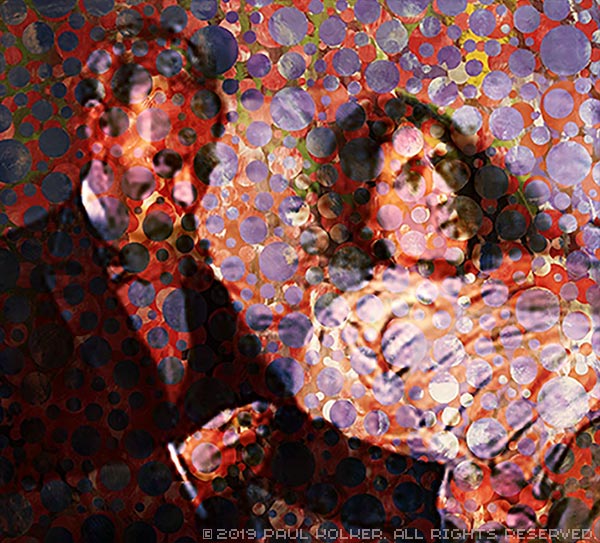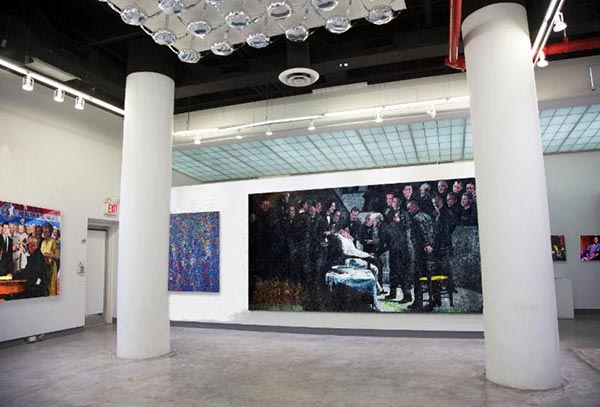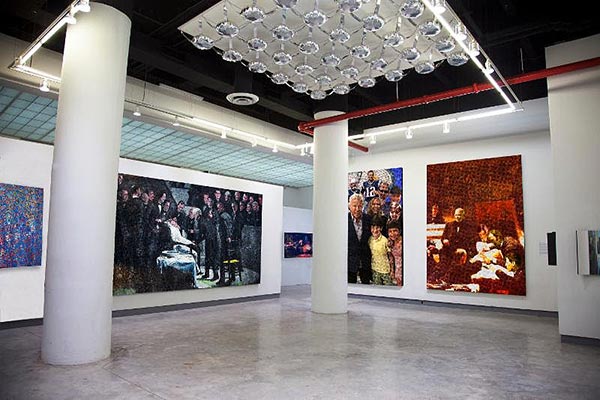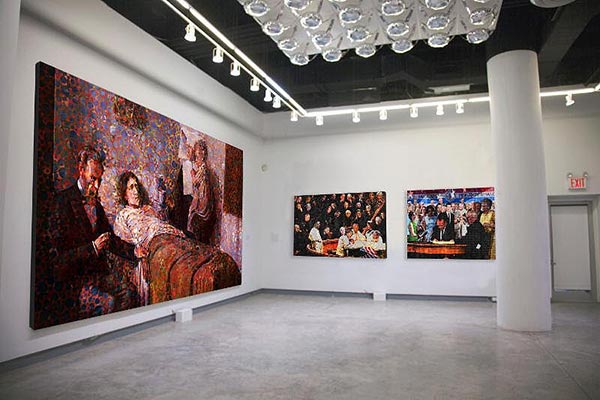
Paul Kolker: the doctor… science and sentience ishidots4 synthèse, 2019 (detail)
inkjet, acrylic and polyurethane on canvas
132 x 220 inches in sixteen parts
Kolker posits that, as enacted by the 111th US Congress’ ACA, so-called affordable and universal healthcare insurance, including the medicaid expansion of existing public options and state health insurance exchanges must remain mandatory in the public’s interest and general welfare, using the same rational basis used by the courts and state legislatures since 1925; mandating that operators of vehicles shall have insurance because of a concept based on ‘affordability’ when a sufficiently large enough pool of insureds share the costs. In regards to health insurance, the premium revenues from this enormous pool of insureds should cover all comers; even those with preexisting conditions or genetic profiles for diseases discoverable on blood testing. The cost of the premium is actuarily calculated using an algorithm which uses the costs expended for medical care as ‘medical loss’ and are generally more than 80 percent of the total; with administrative costs, profits and brokerage fees the remainder, amounting to more than $650 billion, is 20 percent of the predicted national healthcare expenditure for 2019. Kolker questions in his video essay: Is it perhaps that insurance premiums remain unaffordable when more than nearly 20 percent of premium costs go for administration, marketing and profit (AMP)? Is it possible that if half of the AMP is shifted to the medical loss component, bringing it to 90 percent, all uninsured can be covered by insurance without raising another dime? What will happen to the ACA, held unconstitutional in 2018 by the Northern District Court of Texas and now being heard by the Third Circuit Court of Appeals? Are the mandate, medicaid expansions and state exchanges severable from the ACA? What’s next… and on whose dime?

Paul Kolker: About Healthcare… What’s Next And On Whose Dime?
(installation view)
Paul Kolker: About Healthcare… What’s Next And On Whose Dime?
(installation view)
Paul Kolker: About Healthcare… What’s Next And On Whose Dime?
(installation view)As depicted above in the installation mock-up views of the show, Kolker adds collage and alters color, translucency and contrast to transform photographs of renowned healthcare paintings by Pablo Picasso, Robert Hinkley, Thomas Eakins, Sir Luke Fildes and John Singer Sargent using a process Kolker calls synthèse; the medley of figural and abstract paintings which are sandwiched together by painting overlays of acrylic glazes or, alternatively as in this exhibition, by printing digital stacks of photographed layers of figural and abstract paintings with archival inks on canvas.
A close up of one of the paintings, ‘Paul Kolker: the doctor… science and sentience ishidots4 synthèse, 2019‘ demonstrates Kolker’s synthèse effects; painterly blending of subjacent colors cast onto the four abstract layers of dots residing above the plane of the figural images and which expand the viewer’s perception of the illusions of depth, gesture and being enveloped in a foamy, fractal-like atmosphere of multivariate bubbles. This assemblage of dots of many sizes, which Kolker calls ‘ishidots,’ is used today in the color blindness test charts first painted by the ophthalmologist Dr. Shinobu Ishihara in 1915.
In Paul Kolker: About Healthcare… What’s Next and On Whose Dime?, fifteen new works are on view from September 12 through November 15, 2019 at the PAUL KOLKER collection, 511 West 25th Street in Chelsea, adjacent to the HighLine between Tenth and Eleventh Avenues.
Paul Kolker: Abstract Decalcomania… An Experiment in Perception is ongoing at 600 Third Avenue.
For information or press materials, please contact us via email.
